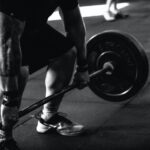
Table of Contents (click to expand)
Introduction to Weight Lifting
Weight lifting, an integral component of strength training, is an exercise regimen that’s not just about gaining muscle mass or becoming more muscular. By involving both upper body and lower body exercises, weight lifting is a versatile activity that enhances strength, promotes muscle growth, and even helps lose weight. It leads to a more confident self, improved muscle endurance, and a better body fat percentage. Yet, when starting out or even after some time into the regimen, one question tends to surface: How much and how much weight should I be lifting?
The Concept of ‘How Much Weight Should I Lift’
The question is the backbone of weight, resistance, and strength training. It aims to find the balance your muscles need to grow without causing unnecessary stress on muscle fibers that might lead to injuries. In essence, the right weight challenges your muscle fibers enough to trigger their growth and the subsequent repair process, yet it doesn’t push them to the point of damage or undue strain.
Related: What Weights Should I Be Lifting?
Understanding Your Body’s Capabilities
Before you can answer this question, it’s essential to understand your body’s capabilities. Factors such as your fitness level, age, and overall health condition play a pivotal role in determining your capacity to lift weights. Some people are naturally more assertive, while others may need to work harder to build strength. Working with a personal trainer can help evaluate these parameters and guide you on the appropriate weight to start lifting, setting the foundation for a successful weightlifting journey.
Factors Influencing ‘How Much Weight
One of the most significant factors is your specific strength training goals. If you want to gain muscle size or mass, lifting heavier weights for fewer reps might be your route. On the contrary, if you focus on muscular endurance or wish to lose fat, a lighter weight with a lower rep range and higher reps might be more beneficial.
The Importance of Proper Form in Weight Lifting
Good form is the backbone of effective weightlifting. Without maintaining proper form while lifting weights, the entire exercise might prove ineffective or lead to injuries. The excellent form ensures that the correct muscle groups are targeted, helping aid muscle growth. For example, when performing an overhead press, maintaining a straight back and ensuring that the max weight of the barbell stays directly over your head at the peak of the lift is necessary for correct form.
Understanding Strength Training
Strength training, often synonymous with resistance and weight training, is a form of exercise that enhances muscle strength and endurance. Whether lifting your bodyweight or using external weight, strength training exercises like bench press or bodyweight exercises cause your muscles to contract, improving your muscle mass, tone muscular endurance, and overall fitness level. They also help enhance your performance in other physical activities, improve bone density, and increase calorie burn, helping to maintain a healthy body fat percentage.
Related: How Many Calories Do You Burn Lifting Weights: A Comprehensive Guide
Weight Training Versus Cardio: A Comparison
While cardio exercises like running or cycling are often highlighted for their role in improving cardiovascular health and aiding in fat loss, weight training brings a host of benefits to the table. These include muscle growth, improved self-esteem due to the visible results, a higher resting metabolic rate, stronger muscles, and better mental health. Generally speaking, a balanced fitness regimen should ideally incorporate both cardio and weight training.
Setting Weight-Lifting Goals
In weight training, setting realistic and measurable goals is crucial. These goals should act as your guiding light, helping you determine your path. Whether you aim to lose fat, build muscle, or increase strength, these goals will directly influence how much weight you should be lifting. For example, you should raise a heavier or more weight for fewer reps to increase muscle size.
Knowing Your One Rep Max (1RM) in Strength Training
Your one rep max (1RM) is essential in weight lifting. This term refers to the maximum weight you can lift for one repetition of a given exercise. Knowing your 1RM is particularly useful in designing your training program’s ideal weight out, as it allows you to measure your progress and set appropriate workout intensities. It provides a benchmark, making it easier to track improvements in strength over time.
The Role of Progressive Overload in Weight Training
The principle of progressive overload is a vital cog in the weight-training machine. This principle concerns the gradual increase of stress placed upon the body during exercise. In simpler terms, as your body adapts to the given weight, you should continually add more weight or increase the number of reps to challenge your muscles. This aids in increased strength, better muscle endurance, and greater muscle mass over time.
Related: What to Eat Before Lifting Weights
How Much Weight Should Beginners Lift
When starting with weight lifting, the focus should be on learning the proper technique and form rather than lifting heavy weights. Start with light weights or even an empty barbell, and gradually add heavier weight as your muscles strengthen and you become more comfortable with the exercises. Remember, the goal isn’t to impress anyone with how much you can lift. Instead, the aim is to challenge your muscles safely and effectively, laying a solid foundation for your weight-lifting journey.
How Much Weight Should Intermediate Lifters Be Lifting
As an intermediate lifter, you’re likely to be capable of lifting heavier weights than when you were a beginner. However, the key at this stage is not just about lifting heavier or lighter weights—it’s about finding the right balance. This sweet spot is where the weight is challenging enough to stimulate muscle growth and improve your strength but still allows you to complete the full range of motion with good form. This generally falls within the moderate difficulty level of your perceived exertion.
How Much Weight Should Advanced Lifters Be Lifting
Once you reach the advanced stage, you’ll understand your capabilities well and likely be able to lift heavy weights while maintaining proper form. At this stage, lifting near your maximum weight for fewer reps can help to improve strength and muscle size. However, remember that even at this stage higher weight only, it’s vital to listen to your body to avoid overtraining or injury.
Importance of Rest and Recovery in Weight Training
Rest and recovery are often overlooked aspects of weight training, but they’re crucial to the process. After a heavy lifting session, your muscles need time to repair and grow. Not giving your body enough time to rest and recover can lead to muscle failure and potential injuries. This is why a well-structured training program will always include rest days. Remember, weight training is about quality, not quantity.
Proper Form Techniques for Weight Training
Proper form techniques can vary widely depending on the specific exercise. For lifting weights, for instance, while doing a bench press, keeping your feet flat on the floor and your back flat against the bench is crucial. The barbell should align with your chest, and you should use a full range of motion for each rep. Ensuring correct form not only helps to target the right muscles but also reduces the risk of injury.
Related: What is Weight Lifting?
Weight Lifting Equipment: Understanding What You Need
Depending on the weight-lifting exercises you plan to incorporate into your routine, you’ll need different types of equipment. Barbells, dumbbells, and weight machines each serve a unique purpose and can be used to target specific muscle groups. Additionally, supplements like protein powder can aid muscle recovery and growth, ensuring you’re fueling your body correctly to support your weight-lifting endeavors.
Injury Prevention in Weight Training
Preventing injuries in weight training involves more than just using proper form. It also requires listening to your body and understanding when it’s time to rest. Always begin your weight lifting sessions with a warm-up to prepare your muscles and end with a cool-down to facilitate recovery. If you experience any pain during a workout, immediately stop the exercise and consult a sports medicine professional.
How to Increase the Weight You’re Lifting Safely
Increasing the weight you’re lifting safely involves applying the principle of progressive overload. This involves gradually increasing the amount and rep range of weight you lift over time. Start lifting the same weight until you can comfortably perform more reps than your target. Then, increase the weight slightly, returning to your original rep range.
Case Studies: Successful Strength Training Journeys
Countless inspiring stories of individuals who have transformed their bodies and improved their self-esteem through weightlifting. These stories testify to the power of weight training and demonstrate that anyone can achieve their fitness goals with the right approach.
How Much Weight Should I Lift at My Weight?
The amount of weight you should lift doesn’t directly correlate to how many reps are with your body weight. It depends more on your strength and fitness level. As a rough guide, a beginner might start lifting 50-60% of their one rep max (1RM). The 1RM is the maximum weight you can lift for one repetition of a given exercise. As you progress and build strength, this percentage can increase.
Related: Why is Weight Lifting Good For You?
Frequently Asked Questions
How Much Weight Should I Lift as a Beginner?
As a beginner, the main focus should be learning the correct technique and form rather than the actual weight. You can start with light weights or even just the barbell. Once you’ve mastered the process, you can gradually increase the weight so that the last two repetitions of your set feel challenging but still manageable.
How Much Weight Should I Lift for Muscle?
You need to lift heavy weights to fatigue your muscles within 6-12 reps to stimulate muscle growth. That typically equates to heavy weight up to around 60-80% of your 1RM. However, it’s essential to remember that muscle growth isn’t only about lifting heavy weights; it’s also about nutrition, rest, and consistency in your workouts.
How Much Weight Should You Lift to Lose Weight?
To lose weight, combining cardio with resistance training can be highly effective. The weight you lift should be light enough to allow you to perform about 10-15 repetitions per set and heavy enough that your muscles feel fatigued by the last rep. This approach can help burn calories, build lean muscle mass, and boost metabolism, contributing to weight loss.
Related: What Do Bodybuilders Sniff Before Lifting Weights?
Conclusion: Finding Your Weight-Lifting Balance
In conclusion, finding the right weight to lift is a process. Remember, the number on the barbell or the light dumbbells is less important than how the weight feels to you. You’re on the right path if you’re challenging yourself, maintaining good form, and continually making progress. Happy lifting!





































